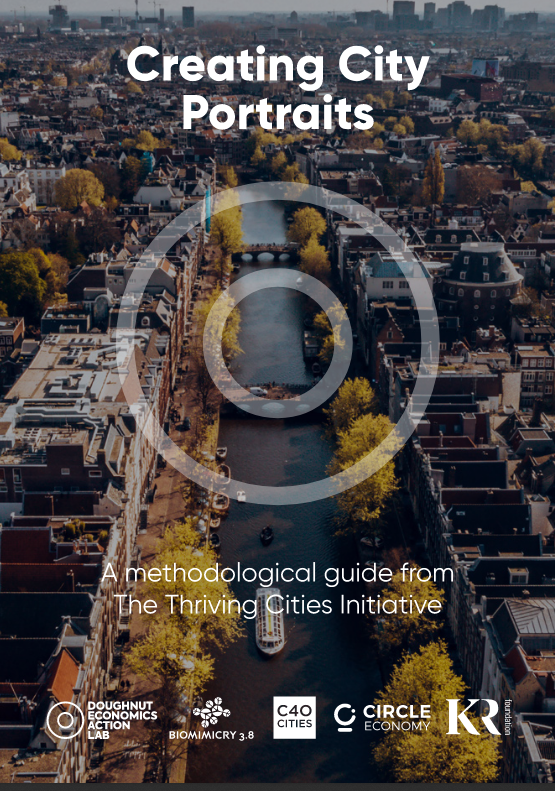
In an early post I reviewed Kate Raworth’s book ‘Doughnut Economics’.
One of the many critiques I heard in different contexts about the contents of this book has been: ‘All nice and well. While the critique is justified – the alternative is just theory.’
While not unsurprising – it is a critique after all often voiced about just about anything that goes against the status quo – it is correct that every theory needs practice to go with in. In the case of economic theories this means: implementation. Be it by trialling, testing, developing algorithms or in any other way: ‘getting it done’ is the only way for the rubber to hit the road.
Over the last 12 months, the Doughnut Economics Action lab developed a methodology – denominated ‘Creating City Portraits’ – , tested in three different cities of the global North (one in Europe: Amsterdam NL; and two in the US: Portland OR, and Philadelphia PA) to breakdown the Doughnut Concept into concrete, measurable short-term actions as well as mid- and long-term goals.
They key question asked is: How can your city become a home to thriving people, in a thriving place, while respective the well-being of all people and the health of the whole planet?
Kate Raworth [emphasis added by the author]
The methodology, and the outcomes for Amsterdam have recently been published – in conjunction with Amsterdam’s public and very widely publicised commitment (e.g. here, here, here, here and here) to the implementation of the goals and actions stated.
But while we are all aware of policy makers playing a huge role in any of such developments, and probably local policy makers more than anyone else among their guild: business are an integral part of local, regional, national economies. They are at the heart of change as much as individual citizens and policy makers are. After all a business person – as much as a policy maker – is also a private citizen, and cannot just check their ethics when taking on their more public role.
So, how about the question to the C-Suite and the board of any company, small or large, listed or not:
How can your company become a workplace to thriving people, in a thriving place, while respective the well-being of all people and the health of the whole planet?
Pamela Ravasio, adapted from Kate Raworth
Hence,
Can the methodology outlined in ‘Creating City Portraits’ be used for businesses? To what extent? How?
The brief answer is yes – in my view.
Albeit an effort would be needed to run through an exercise similar to the one with the three cities mentioned above. Just with businesses instead of cities. And maybe with a somewhat larger number of participating candidates representing the diverse sizes of businesses in our economies.
My guess is further that the mid-sized business community could be at an advantage relative to both, the very large business and the very small ones – both hampered precisely by their respective sizes.
Interestingly, the lenses used in ‘Creating City Portraits’ could translate fairly easily to businesses also. Importantly – they would consciously require businesses of all sizes to see themselves as both local and global citizens and players. Which may be novel to the small ones, and a back-to-roots reminder for the very large ones among them:
|
| Social | Ecological | From Business to Communities and Cities |
|
Local
| What would it mean for the employees of this business, at this specific workplace, of this local community (e.g. city) to thrive? | What would it mean for this business, at this location to thrive within the natural habitat? | How would the business contribute for its city/community to equally thrive? |
|
Global
| What would it mean for this business to respect the well-being of people worldwide? | What would it mean for this business to respect the health of the whole planet? | How would the business contribute for its city/community to respect the people worldwide and the whole planet? |
Table 1. First try translation: From the four lenses of the City Portrait to four lenses for business.
Company Evolution: Purpose, Stakeholders, Long-term Value
It is evident that the above lens questions are interesting and challenging because to answer them an engagement process across all seniority levels, and across all stakeholder categories is needed: From customers over suppliers to accountants; from customer service to COO and CEO; and from shareholders to local legislators and politicians; from public services to those living in the nearby residential neighbourhoods.
They are also challenging because the process cannot possibly be answered in a top-down manner, but because it is an approach that by necessity is bottom-up. A process that will result in differing, sometimes complementary and sometimes diverging, answers by location and geography – all of which nonetheless have to find a common denominator valid all across a business.
Thankfully this is an approach, that business is very familiar with in other context: that of marketing and sales, where local requirements, mores, habits and relationships drive a global agenda.
The biggest challenge for a business may though be: not putting itself at the centre of the goals and outcomes any more. But instead – truly in the way of a purpose-led organisation – put the long-term, the communities and the thriving of societies at the centre.
Getting that mind-shift to happen, and giving it the space to develop, to take root, and for it to flourish into concrete achievements – THAT is the hard thing to do in a business.
The rest – comparatively peanuts.
Further learning:
- Creating City Portraits. The whole method explained and illustrated with the Amsterdam example.
- While including a number of pre-forged ideas, and not quite reaching as far as the Doughnut Vision, B-Corp certification is a good first path to structure the complex interface between business needs, stakeholder requirements and the global societal and environmental requirements. The B-Corp self-assessment is freely accessible.
- To be launched in September 2020: Doughnut Economics Action Lab. Want to be part of their effort, use their tools or the like? Fill out this from to be kept informed.


